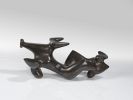
Max Kratz
Remscheid
1921 -
Düsseldorf
2000
Max Kratz is born on May 3, 1921, in Remscheid. Still a child, he makes sculptures with anything he can gets his hands on.
From 1935 until 1940 on the wish of his father, he studies for a "respectable" career as a goldsmith. After completing his apprenticeship and trade tests, he attends the school of applied arts of Krefeld. Besides his studies, he works in the studio of a sculptor in Düsseldorf. Max Kratz attends for the obligatory duty for the Hitler Youth, which he spents in the glider pilot regiment of the German air force.
In 1941, he passes the entrance examination for the art academy of Düsseldorf, where he attends the class of Professor Bindel. The same year, he is drafted into the German air force where he serves from 1942 until 1944 and is stationed on various fronts. Whenever stationed in France, Max Kratz repeatedly visits the Rodin Museum in Paris.
In January of 1945 while working as a medic, he is captured by the English and held captive in a Belgian prison camp, where Max Kratz carves and draws in order to survive the severe camp conditions, and from where he is released in May 1946.
In June, he takes up his studies in sculpting and attends the class of Professor Sepp Mages, where he meets his colleague and future wife, Gerda. A private commission enables him to establish his own studio in 1950. Max Kratz marries one year later and continues executing his own works and commissioned works.
In 1953, his first son, Thomas, is born.
In 1954, Kratz spents six month in a sanatorium recovering from tuberculosis, a delayed effect of his time in the prison camp. After two more stays in sanatoria during 1955 and 1956, Max Kratz finally recovers, due to a new medical treatment. His first public commission "Türgriffe" originates from this time.
From 1956 until 1970, Kratz carries out numerous religious and secular commisions; he experiments and executes free works in his studio using lead, glass, stone, bronze, steel, and later synthetic materials. Apart from his wife Gerda, several other colleagues work in his studio. The studio atmosphere is marked by hard working during the day and celebrating together at night. During this period, Kratz also traveles many places all over the world.
In 1970, he accepts an appointment to the Folkwangschule in Essen and enjoys his work thoroughly. Three years later, Max Kratz is appointed to a professorship at the University of Essen. Still yet, he executes freelance works and participates in competitions.
In 1984, he wins the competition for a miner’s memorial for the city of Essen. A year later, he begins to realise his work "Steile Lagerung" and recieves the early emeritus status from the university. "Steile Lagerung" is completed and presented in 1989.
After a protracted illness, Max Kratz dies on July 2, 2000, in his home in Düsseldorf.
Would you like to sell a work by Max Kratz?
Infos for seller




